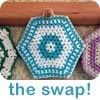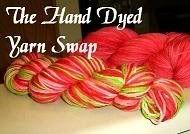I decided to start by finding out what beginners at my local yarn shops were knitting.
At Bluebonnet Yarn Shoppe, beginners are usually guided towards a scarf or a dishcloth, according to Suna, who teaches some classes there. The scarf or dishcloth may be in garter stitch or in a basket weave, depending on on whether the student learns the purl stitch. (We'll talk about what the stitches mean later on.)
Staci, who teaches at The Knitting Nest, said she usually teaches a "Garter Stripe Scarf" made from a combination of knit and purl stitches.
Tracy took the Knit 101 class at Hill Country Weavers. She said they began with dishcloths knit in a stitch pattern similar to Staci's garter stripe scarf.
I'm not sure if there is a specific project at Gauge, but I have witnessed Karli and the gang getting customers started on garter stitch scarves.
I learned from my Mom, with projects from The Workshop Book of Knitting
 If you're having trouble seeing it, its a bookmark. One small square (about one inch by one inch) with a long tail added to go into the book. Tiny. Easy. Genius.
If you're having trouble seeing it, its a bookmark. One small square (about one inch by one inch) with a long tail added to go into the book. Tiny. Easy. Genius.(I'm sure I have the actual bookmark somewhere, but I couldn't find it to take a picture. I'm sure it's packed away in a box somewhere.)
Most first projects are garter stitch rectangles. That's about as easy as it gets. Most stitch patterns are built on two stitches, knits and purls. The garter stitch is nothing but knit stitches. (With the exception of knitting in the round, but don't worry about that right now.)
When I asked around online, Suna and Jean said they both started with doll blankets. Diana said she knit a coin purse from a kit. (I imagine this was one or more rectangles sewn together.) And some of the yarn shops do dishcloths.
But by far, the most common first project is a garter stitch scarf. It seems to be the place where everyone starts. Stefanie, Michelle and Jane said that's where they started.
Christine said her first attempt was with a garter stitch scarf "because my grandmother told me I had to learn a scarf. Yuck. I hated it and never finished." Sounds like the new knitter in Demchuk's article. (Knitting later stuck with her when she knit a dishcloth.)
But then there's Catherine who said she did nothing but garter stitch scarves during the first four years of knitting.
So a garter stitch scarf is one place to start. But really any rectangle will work. You can call it whatever you want.
I mentioned knit and purl stitches were the two main foundation stitches in knitting. The knit stitch seems to always come first.
Personally, I think getting comfortable with the motions of the knit stitch before tackling the purl stitch makes sense. You need time to get used to holding the needles.
I think some teachers throw in purling the first project to prevent boredom. However, the main drawback of spending a long time knitting before you learn to purl is that you find yourself more comfortable with knitting than purling.
In her book Knitting Without Tears
"Why do so many of us object to purling? Is it because as children we are taught to knit first, and are then presented with purling as the second and more difficult step? Who knows? Who is willing to take a little innocent child and teach it to purl first? You must admit it's the trickier of the two."I think that says it all.
A few people who responded to my questions about first projects talked about starting with
larger, much more elaborate projects.
Ceci started with a top designed by Lily Chin. She was successful. She credits Ana, her teacher (and sister) for her success. Ana herself started with (and these her exact words) a "V-neck button-up vest with knit/purl texture panels made from cotton." (She adds "Yeah, I jumped straight into the deep end.") It must have worked, because Ana is still knitting today.
And then there's Pammie's story:
"My first knitting project was an afghan! Cabled strips that were to be sewn together! I never finished it. Last year I did something else with the yarn after over ten years. It took me a long time to pick up knitting after I started that monster and never finished it."Eventually, Pammie did a garter stitch scarf, and it stuck.
Starting with large projects works for some, but I have a feeling it fails for most. In his article, Demchuk recommends socks as an ideal first project, to prevent boredom. This is a pretty radical idea, and I don't know it I'd recommend it. Socks may be small in size, but usually they are big on time and effort until you get the hang of them.
Personally, I think the best way to learn to knit is to just knit. Don't make a project. Just practice. Knitters knit for practice of experimentation a lot. It's called swatching.
I once heard of someone who decided to knit a complex cabled baby blanket. And she managed to learn enough to do it, but she never knit again. She wanted to make a project. She didn't want to learn to knit.
This is going to sound harsh, but it's true. Your very first knitting will suck. It won't stay that way, but it will take practice before it doesn't suck. When you first learned to write, it was probably illegible at first. If you've learned to play an instrument, you know it sounded bad at first. And when you learned to ride your bike, you probably fell off a few times.
The good thing about knitting is that when you make mistakes, you don't end up with skinned knees. And yarn unravels. So just muddle through until you get it. You'll see your knitting change for the better as you progress. The problem is that if you start a project right away, all that muddling may screw up your scarf, dishcloth or whatever that you make.
However, it's been mentioned to me that it is frustrating for many beginning knitters to not have a project or goal in mind. And at some point you want to start knitting something. But consider just practicing first.
Another tactic is to just accept that there will be mistakes in your first project. I've seen a first time knitter sit and unravel her scarf over and over again because it wasn't good enough. She did learn, but it made it frustrating for her. Even if you do a project, it helps to get out of the project frame of mind.
So what does this all mean? You can come at your first project from all different angles. You should do what works for you, but here is my advice.
Keep it a small, simple rectangle. You'll be less frustrated if you start with just the knit stitch and get used to knitting. And you'll get a feeling of accomplishment when you finish. You also combat getting bored with something too easy. The next project can always be harder.
Don't make your scarf so friggin' wide! Back to Demachuk's article, don't get yourself stuck in the middle of a giant scarf. I think a lot of beginners make their first scarf extra wide because they feel like it needs substance. Err on the side of skinny. Skinny scarves are in (I think.) Or if you want a wider one, make it short and wear it with a pin. Also, set a specific goal for length, so you don't feel like you're knitting into oblivion. This is good advice for knitting any scarf. I'm about five feet tall, and usually I knit my scarves until they are about as long as I am tall.
Get out of the project mindset. Start with swatching for practice, or accept that there will be mistakes in your project. Don't quit knitting because you got frustrated with that specific project.
Don't unravel too much. You may want to fix huge mistakes, but I don't recommend aiming for perfection when you are starting out.
It's ok not to finish. If you chose something too hard, abandon it for something easier. You can always come back to it, or use the yarn for something else. If it's too easy and you're bored, move onto to something more challenging. Like Demchuk said, you can always make that scarf a potholder and move on.
And always remember - Don't give up. And if you don't like my advice do what works for you. My feelings won't be hurt.
Thanks to everyone on Ravelry who answered my posts and contributed their experiences and advice.








1 comment:
I made a teddy bear sweater. I have all of the pieces in a drawer somewhere... if I had attempted a garter stitch scarf, I would have slit my wrists before it was finished. I am in awe of those who have the patience to make one!
Post a Comment